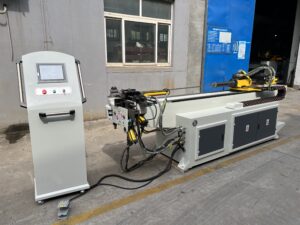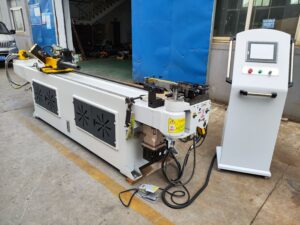Pipe Bending machine
At the bend, because of tension and compression reacting opposite each other, there will be a set of unequal stresses that can cause the pipe to kink, flatten, or collapse.
In order to prevent these issues from arising.a filling material can be used to support the wall of the pipe in providing some more stability during the bending operation.
When a filling material is used there are various techniques that can be done to provide the pipe with inner wall support. Usually some filling material is used and poured into the pipe. In some cases it is melted with a commercial alloy of bend alloy. This ally is melted at 160 degrees Fahrenheit and is composed of bismuth, lead, tin, and cadmium. This filler will conform to the inner tube so that the tube can be bent just like a solid rod. The filler is then removed after the bend by melting. In other cases very fine grain sand can also be used as a filling material. The advantages of using sand are that it is cheap, readily available, and doesn’t have to be melted. The sand can be poured into the tube as before, and can be poured out when finished.

Minimum Radius
The safe minimum radius for any given diameter material, and method of bending depends on the density or thickness of the pipe wall.
General Rule
Wrought iron or steel pipe of standard weight may readily be bent to a radius equal to five or six times the nominal pipe diameter. Also, the minimum radius for a standard weight pipe should be 3 to 4 times the diameter.
Finding Lengths of Bends
When determining the required length of a pipe before bending, the lengths of the straight sections are added to the lengths of the required curved sections. This will prevent in cutting a pipe too short to size. In other words, it will make proper allowance for bends.
Rule for 90 degree and 180 degree Bends
90 degree bends:
Multiply the radius of the bend by 1.57 (Radius is measured to the center of the pipe) To find the length of a 90-degree bend.
180 degree bends:
Multiply the radius of the bend by 3.14 to find the length of a 180-degree bend.
All other bends:
Multiply the radius of the bend by the induced angle, and then multiply the product by the constant 0.01745.




